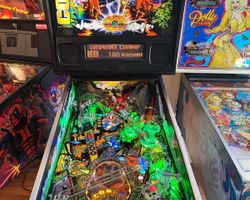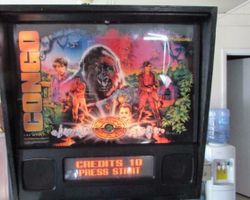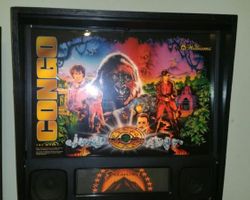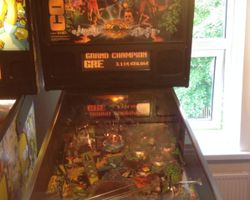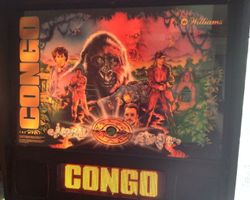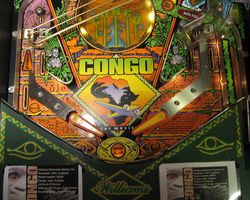Congo
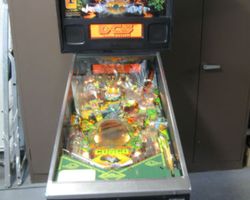
Average Prices: USD $700 to $3,900
Produced: November, 1995
Production Run: 2,129 units
Machine Type: Solid State Electronic
MPU: Williams WPC-95
Players: 4
Design by: John Trudeau
Art by: Kevin OConnor
Music by: Vince Pontarelli
Sound by: Vince Pontarelli
Software by: Bill Grupp, Dean Grover
"Congo," a pinball machine brought to arcades and homes by Williams Electronic Games, Inc. in November 1995, emerged during the prolific WPC-95 era of pinball manufacturing. The machine draws its theme directly from the adventure film of the same name, immersing players in a quest for diamonds deep within a perilous jungle. This licensed title represented Williams’ commitment to leveraging popular culture, transforming cinematic thrills into interactive pinball action.
The development of "Congo" involved a team of seasoned pinball creators. John Trudeau, known for his ability to craft engaging playfields, served as the game designer, shaping the flow and shot geometry. Kevin O'Connor's artwork defined the machine's visual identity, rendering the vibrant and dangerous jungle environment on the playfield and cabinet. The auditory experience, crucial for immersion, was meticulously crafted by Vince Pontarelli, who composed the music and sound effects. Software engineers Bill Grupp and Dean Grover translated the design vision into responsive gameplay, programming the rules and animations that brought the virtual jungle to life.
"Congo" marked a significant moment in Williams' history, being the last pinball machine produced at their long-standing California Avenue facility, which had been the home of Williams machines since 1967. Following "Congo," pinball production transitioned to a new facility in north-east Illinois. With a confirmed production run of 2,129 units, "Congo" was also offered as a conversion kit, allowing operators to update existing Williams WPC Security cabinets with new playfields, game ROMs, and decals, providing a cost-effective way to introduce the new theme. A notable piece of trivia highlights the attention to detail: the gorilla figure on the lower-level playfield was sculpted by Stan Winston, a respected artist in special effects. Early prototypes even featured unique aesthetic differences, such as a lighter green apron and varied insert text, underscoring the iterative nature of pinball development.
Signature Features and Design
"Congo" distinguishes itself with several unique features that elevate the gameplay experience beyond standard shots and targets. Central to its allure is the "Volcano" toy, a prominent and dynamic mechanism on the upper playfield. This physical volcano erupts, spewing balls into a dedicated multiball sequence, delivering a visceral and exciting centerpiece. The volcano shot is a prime example of how physical toys can integrate seamlessly into core gameplay, providing a satisfying visual and mechanical reward.
Another standout element is the "Amy" feature, named after the talking gorilla from the film. This translates into a mini-playfield located on the main playfield, visible through a clear window. Within this smaller arena, a sculpted gorilla figure acts as a turning flipper, allowing players to direct a captive ball at specific targets. This adds a layer of precision and novelty, distinct from traditional flipper mechanics. Furthermore, a separate lower playfield, often referred to as the "Gray Gorilla" area, offers another dimension of play, accessible through specific shots. This multi-leveled design broadens the scope of the game, encouraging exploration of different playfield zones. The game further enhances its jungle theme with custom speech, utilizing voice lines from the movie to guide players and provide thematic feedback, contributing significantly to player immersion. The overall art package, with its vibrant playfield colors, effectively portrays the dense, mysterious jungle setting, complementing the mechanical features with a consistent visual narrative.
Playfield and Mechanics
The playfield layout of "Congo" is designed for speed and accessibility, offering a fluid experience for a wide range of players. Two primary ramps define much of the playfield flow: the "Left Ramp" is a crucial shot for spelling "M-A-P" letters, integral to unlocking significant awards. The "Volcano Ramp," situated through the pop bumpers, feeds into the game's signature volcano toy, crucial for initiating multiball. Three traditional pop bumpers reside in the upper-mid playfield, vital for adding "H-I-P-P-O" letters, which contribute to bonus scoring.
The machine features a standard complement of two lower flippers, augmented by an "Upper Flipper" strategically placed to access the "Amy" mini-playfield and the Volcano Ramp. The left outlane is protected by a "Kickback," lit by three distinct targets, offering a reprieve from unexpected drains. The main playfield is replete with various targets and lanes, including a "Left Orbit" that cycles the ball around the top, and a "Gray Lane" dedicated to spelling "G-R-A-Y" for a specific mode. Two "Satellite Targets" activate a timed mode, while a set of three "A-M-Y" rollovers lead to the "Amy Saucer," initiating the unique gorilla-themed mode. Multiple kickout holes, including the "Lock" saucer for multiball initiation, and the "MAP Saucer" and "Mystery Saucer" for collecting awards and starting modes, punctuate the playfield, providing distinct objectives and ball returns. A single "Captive Ball" also offers a satisfying target.
Artwork on the playfield consistently reinforces the jungle theme with lush greens, earthy browns, and vibrant accents, creating a cohesive aesthetic. The lighting scheme utilizes a combination of general illumination and targeted inserts to guide players through objectives and highlight scoring opportunities, effectively directing attention to active shots and modes. The general design philosophy prioritizes a "shooter's game" feel, where clean shots are rewarded, and the ball paths often return to the flippers, maintaining a sense of control and flow.
Gameplay Dynamics
The gameplay dynamics in "Congo" revolve around a progressive scoring system centered on collecting "Diamonds." Players gather diamonds by hitting various lit shots and completing objectives across the playfield, with a cumulative goal of collecting 100 diamonds to initiate the coveted "Super Multiball," a five-ball frenzy designed for high scores.
Multiball is a core element, typically initiated by locking three balls in the designated lock saucer. Once multiball commences, players aim for lit ramps and targets to score jackpots, driving up their score. Beyond standard multiball, "Congo" features several unique modes and challenges that distinguish its gameplay. The "M-A-P Awards" are unlocked by repeatedly shooting the Left Ramp to spell out M-A-P. Once completed, the MAP saucer lights, offering a rotating selection of awards, including extra balls, the "Jungle Jackpot," or the two-ball "Diamond Hunt Multiball," where all diamond shots are lit for rapid collection. The "Jungle Jackpot" can further escalate into the "Ghost Tribe Multiball," adding layers of progression.
The "A-M-Y Mode" is activated by completing the A-M-Y rollovers and shooting the Amy Saucer. During this timed mode, players attempt to shoot the upper upper orbit, often for double scoring, aiming to collect diamonds through precise shots. The "GRAY Attack" mode activates the lower playfield once the G-R-A-Y letters are completed. Here, players must hit "C-O-N-G-O" targets within a time limit, with varying awards based on performance. The "Mystery Saucer," lit by completing "Z-I-N-J" targets, offers a range of random awards from points to extra balls or even starting the "Video Mode."
"Congo's" "Video Mode" requires players to steer a boat using the flipper buttons, navigating through waves of rocks and hippos while collecting diamonds, providing a distinct change of pace from traditional pinball action. Another unique feature, "Midnight Madness," is a special operator-set mode that activates when the internal game clock hits midnight, offering a surprise gameplay variation. While the rules are considered by some to be straightforward, emphasizing accessible objectives, strategies often involve prioritizing extra ball opportunities, activating various multiball modes, keeping the left outlane kickback active, and methodically spelling out letters for modes like GRAY and MAP to maximize diamond collection and score.
Reception and Legacy
"Congo" garnered a generally positive reception within the pinball community, often described as an underrated and engaging machine that delivers solid gameplay. Its strengths are frequently highlighted: many players praise its fast, fluid shooting experience and the well-designed shot layout, making it accessible to both new players and experienced enthusiasts. The machine is often cited as a "great shooter," with the Left Ramp and especially the Volcano shot receiving particular commendation as satisfying and impactful targets. The integration of music and sound is also lauded for creating an immersive jungle atmosphere, complementing the playfield's vibrant colors and thematic elements like the volcano, the Amy gorilla, and the lower Gray Gorilla playfield. The various multiball modes are generally considered enjoyable, and the video modes add a welcome diversion. For many, "Congo" represents good value, offering addictive gameplay that encourages repeated plays.
However, "Congo" is not without its criticisms. The most significant point of contention stems from its movie license; the film itself was not widely acclaimed or remembered, leading some to find the theme uninspiring or a barrier to appreciation. The backglass art is frequently singled out for criticism, often described as visually jarring or unattractive, contrasting with the more functional playfield art. From a gameplay perspective, some players feel the rules, while accessible, can be somewhat shallow, leading to repetition after extended play sessions. The lower playfield with the Gray Gorilla, while unique, is sometimes perceived as less challenging or engaging than other game elements. Some players also note the prevalence of kickout holes can occasionally interrupt the flow, and a wider-than-average gap between the lower flippers, sometimes referred to as the "Trudeau gap," can lead to frustrating drains. Mechanical issues, such as the volcano's exit being prone to wear, and repetitive animations on the dot matrix display, were also noted by some operators and collectors.
Despite these weaknesses, "Congo" maintains a positive reputation as a fun and often overlooked machine. It stands as an example of the Williams WPC-95 generation, offering a unique blend of themed features and satisfying shot geometry. Its significance is also tied to its historical position as the final machine produced at Williams' long-standing Chicago facility, marking the end of an era for pinball manufacturing.
Sponsored Links
 Ebay Listings
Ebay Listings
 Auction Results
Auction Results
| Cost | Location | Date |
|---|---|---|
| USD $6,499 |  Florida, United States Florida, United States |
14 June, 2024 |
| USD $6,500 |  Michigan, United States Michigan, United States |
12 March, 2024 |
| USD $5,900 |  Minnesota, United States Minnesota, United States |
25 August, 2023 |
| USD $6,500 |  Iowa, United States Iowa, United States |
12 April, 2023 |
| EUR €6,500 |  Austria Austria |
16 November, 2022 |
| USD $5,700 |  Minnesota, United States Minnesota, United States |
20 August, 2022 |
| USD $6,800 |  Indiana, United States Indiana, United States |
18 July, 2022 |
| USD $6,200 |  Washington, United States Washington, United States |
29 June, 2022 |
| USD $9,500 |  Connecticut, United States Connecticut, United States |
28 May, 2022 |
| USD $7,500 |  Connecticut, United States Connecticut, United States |
27 May, 2022 |


Private Policy · Search Website · Contact Us
As an eBay Partner, we may earn a commission from qualifying purchases made through links on this site, at no additional cost to you.
All trademarks and copyrighted materials remain property of their respective owners. All other content copyright 2007 - 2025 Pinpedia.

